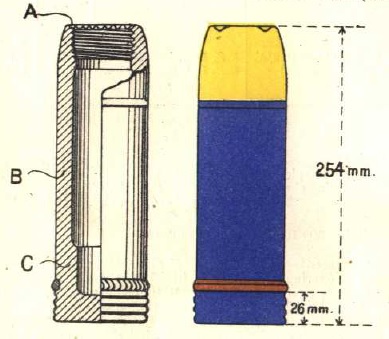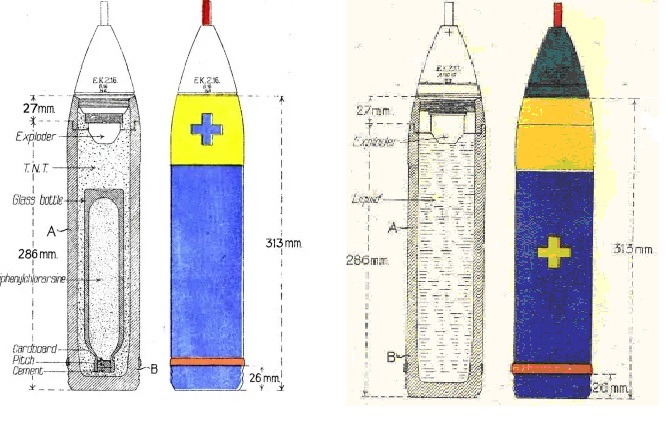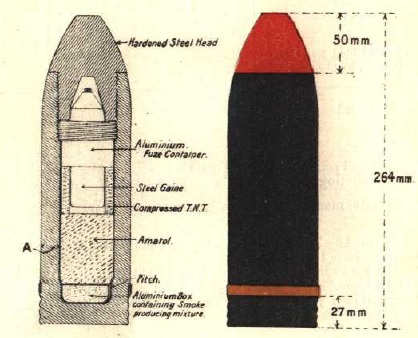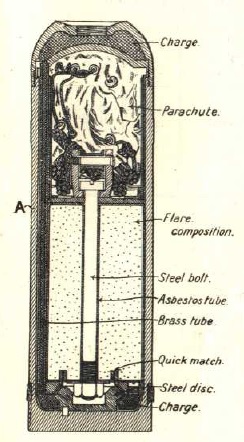The 7.7 cm Feldkanone (Fk) C/96 (Construktion/96) was developed by Krupp for the German Army but with a non-recoiling gun which was therefore rendered obsolete a year or so later when the French adopted the Canon de 75 Mle 1897 with a modern hydro-pneumatic recoil system. The French developed their design based, in part, on the work of Konrad Haussner. However, while working at Krupp, Haussner tried unsuccessfully get them interested in his recoil system and, eventually, had to move to Rheinische Metallwaaren- und Maschinenfabrik AG (now Rheinmetall AG) founded by Heinrich Erhardt to see some of his ideas put into reality. In 1901, the British Army secretly ordered over 100 of the resulting Rheinmetall field guns for use in the 2nd Boer War (1899-1902). These were designated the Ordnance QF 15-Pdr but were often referred to as Erhardt guns.
To remedy the lack of a modern field gun, Rheinmetall and Krupp were tasked with converting the Fk C/96 (since 1899 referred to simply as the FL 96) to long recoil. The new gun used a lighter version of the same barrel but with a new horizontal sliding block breech designed by Rheinmetall along with a long recoil system developed by Haussner. The new gun was designated the 7.7 cm Fk 96 n.A (neuer art or new model) and introduced into service in 1904. Most existing guns were upgraded to the new design over time with unconverted guns subsequently being referred to as Fk 96 a.A (alte or old model). The new field gun was lighter than the British and French equivalents as Germany placed a premium on mobility but this was at the cost of a lighter shell and a shorter range. As a result, the longer barrelled 7.7 cm Fk 16 was introduced in 1916 to overcome these limitations.
 Carriage Design
Carriage Design
The Fk 96 n.A used a single box trail with a spade at the rear to stabilise the gun during recoil along with brake blocks acting against the back of each wheel. It was fitted with wooden spoked wheels 1.36 m (5′ 5.5″) in diameter fitted with steel tyres 70 mm wide. A 4 mm thick gun shield was mounted on the trail with the upper and lower parts hinged for stowage during transport. The gun was normally towed behind a two-wheel limber pulled by 6 horses which carried 36 complete rounds in 3-round baskets. Three gunners were seated on the limber during towing and two more were seated in front of the gun shield on the seats provided.
 Compared with the corresponding British and French field guns of WW1 era, the Fk 96 n.A was of relatively simple design, made even simpler by not employing an independent line of sight – in other words, unlike the Ordnance QF 18-Pdr and Canon de 75 Mle 1897 that allowed the gun to be elevated independent of the sights, the sights on the Fk 96 n.A elevated with the gun.
Compared with the corresponding British and French field guns of WW1 era, the Fk 96 n.A was of relatively simple design, made even simpler by not employing an independent line of sight – in other words, unlike the Ordnance QF 18-Pdr and Canon de 75 Mle 1897 that allowed the gun to be elevated independent of the sights, the sights on the Fk 96 n.A elevated with the gun.

Also unlike the British and French field guns, the Fk 96 n.A cradle was not fitted with trunnions but, instead, pivoted on a gimbal mounted on the wheel axle. This gimbal allowed the cradle to pivot in elevation from -12° to +16° and also allowed the cradle to traverse from -4° to +4° azimuth. The gun was elevated by the left hand gun layer using the large inclined hand wheel which operated a screw jack under the rear of the cradle which attached to a wishbone shaped elevating bracket. The two arms of this bracket pivoted at the front on the wheel axle. The small hand wheel attached to the left of the cradle was used to traverse the gun using a screw fitting into a thread in the rear end of the elevating bracket.

Gun Design

The gun was 2.13 m long with the rifled part of the barrel being 21.2 calibres or 1.63 m in length. The gun was of built up construction with the jacket shrunk on to it and extending for about half of the length of the barrel being securing at the front by a threaded locking ring. Three hoops were shrunk on to the gun along its length supporting a full length guide tray underneath which allowed the gun to slide along runners on either side of the top of the cradle during recoil.
The jacket was shaped at the rear to support a horizontal sliding breech block. The breech was opened using a single motion lever on top of the breech which moved the breech block to the right exposing the breech and ejecting any cartridge in the chamber. The breech incorporated an axial striker to fire a loaded projectile which was cocked and released in a single motion using a lanyard on the right of the breech.

Recoil Mechanism
The Fk 96 n.A used a a relatively simple hydro-spring recoil system mounted within the cradle. This consisted of a hydraulic buffer using a cylinder filled with oil connected to a lug on the breech and therefore recoiled with the gun. The piston within the hydraulic cylinder was mounted on the end of a rod held in position by a pin through the front cap on the cradle. The piston incorporated ports that restricted the flow of oil past it during recoil absorbing the recoil energy and bringing the gun to a stop after firing. The maximum recoil length was 1.27 m (50 in).

A recuperator spring was fitted over the hydraulic cylinder with a flange on the front end such that, when the gun recoiled, the spring was compressed between the flange and rear of the cradle running out the gun fully once the recoil had ended.
Sighting

The equivalent British and French field guns used sighting systems providing an independent lines of sight – this meant that, once the sights were set on the target, they were not disturbed when the elevation of the gun was changed to adjust the range. In contrast, the Fk 96 n.A used a tangent sighting system that elevated with the gun making the adjustment of the gun’s range much more complicated.
The Fk 96 n.A sighting system used a collimator for direct fire and a dial sight for indirect fire. The sighting system was mounted on top of a toothed sight arc that moved up and down on the end of the sight bracket rigidly attached to the left-hand side of the cradle. An adjustable clinometer was also fixed to the sight arc.
The sight arc was adjusted using a knob and pinion on the sight bracket. Raising the arc altered the inclination of the sights tipping them forward. The rear of the sight arc was graduated from 0 to 60 in units of 100 m as well as in degrees. In order to set the elevation of the gun, the angle of sight was first set on the clinometer – this was the elevation angle of the target above the horizontal plane through the sights. The sight arc was then adjusted until the required range was set on the rear scale. Finally, the gun was elevated until the clinometer bubble was level.
Rather than using a conventional telescope as the direct fire aiming device, the Fl 96 n.A used a collimating sight. This type of sight consisted of a rectangular hood through which the target was viewed together with a small collimator in the lower part. The collimator generated a cross-hair reticule in the field of view of the sight effectively focused at infinity. Therefore, what the gun layer saw when looking through the sight hood was the target with the reticule superimposed on it with very little parallax. In use, the gun layer positioned his head about 10 inches behind the sight to use it properly.

Indirect fire was carried out using what the British termed a dial sight and the Germans called a Rundblickfernrohr. The original version of this type of sight was invented in 1906 by a German called Goertz and took the form of a panoramic telescope with an adjustable sighting head that could be rotated from 0 – 360 degrees or 0 – 6400 MILs. The eyepiece was fixed and aligned with the axis of the gun. The sighting head was equipped with an azimuth scale graduated in 100’s of MILs and was normally adjusted using a micrometer knob graduated in 10’s of MILs. The sight was also fitted with another micrometer at the top to allow adjustment of the angle of sight.
During indirect fire, the range, angle of sight and bearing were worked out by a plotting officer using a map showing both the target and gun positions. The target bearing was defined relative to an aiming point defined for the gun, which could be a prominent feature in the landscape or could be aiming posts specially set up for this purpose. To aim the gun in the target direction required the relative bearing to be set up on the panoramic dial sight and then the gun traversed until the aiming point was centred in the sight. This then meant that the gun was pointing at the target.
Ammunition
The Fk 96 n.A fired fixed rounds of the following types: high explosive (HE), universal, Shrapnel, anti-tank, star and gas. In contrast with the British and French shells, the German Army employed a very large number of different types of fuze and therefore only the basic types are listed below.
F.K.Gr (Feldkanone Granade) 96 -HE Shell
This was the basic high explosive (HE) shell used with the Fk 96 n.A and was normally fitted with a Dopp. Z 96 n.A time and percussion fuze. The shell was made from cast steel and was filled with either picric acid or TNT. The shell weighed 6.85 kg and was 254 mm long without the fuze.
The shell was normally used with the percussion fuze to attack more fortified targets. The time fuze was used for air bursts against sheltered targets, such as, troops in trenches.
F.K.G (Feldkanone Geschoss) 11 – Universal Shell
The universal shell was filled with 300 lead Shrapnel balls surrounded by TNT but with a black powder bursting charge in the base. It was normally used with a K.Z.11 time and percussion fuze which allowed the shell to be used either as an air burst Shrapnel shell or as a HE shell that exploded on contact with the ground. The shell weighed 6.85 kg and was 244 mm long without the fuze.
K.Gr.(Kanone Granade) 14 -HE Shell
This was the 1914 version of HE shell which was fitted with either the K.Z. 14 or E.K.Z. 17 percussion fuzed. It was normally filled with Amatol. The shell weighed 6.85 kg and was 242 mm long without the fuze. The shell was of simplified design and made from cast iron and was intended to be capable of being manufactured by private firms. It did not proved satisfactory and was replaced by the 1915 HE shell.
K.Gr.(Kanone Granade) 15 -HE Shell
This was the 1915 version of HE shell and was made from cast steel. It was used with L.K.Z. 11 and K.Z. 11 time and percussion fuzes; and with L.K.Z 16, E.K.Z 16 and E.K.Z 17 percussion fuzes. It was filled with picric acid or Amatol. The shell weighed 6.85 kg and was 242 mm long without the fuze.
L.F.K.Gr.(Lange Feldkanone Granade) -Long HE Shell

This was a longer HE shell introduced in 1916 and was made from cast steel. It was used with the L.K.Z. 11 time and percussion fuze, and with the L.K.Z 16, E.K.Z 16 percussion fuzes. It was filled with picric acid or Amatol. The shell weighed 7.18 kg or 7.35 kg depending on fuze and was 313 mm long without the fuze.
With non-delay percussion fuze, the shell was used to attack living targets either in the open or concealed. The delayed action percussion fuze was used to attack trenches, machine gun posts and also buildings. It was also used when the shell was fired to ricochet off the ground when conditions permitted. The time fuze was used for air burst to attack targets behind shelter or in the open.
F.Schr (Feldkanone Schrapnel) 96
This was the Shrapnel shell used with the 7.7 cm Fk 96 n.A and was filled with 300 lead balls and normally fitted with a Dopp. Z 96 time and percussion fuze. The lead balls were encased in resin around a central tube that transferred the flash from the fuze to the gun powder bursting charge that sat in the base of the shell. A steel disk separated the bursting charge from the Shrapnel balls and was used to push the contents of the shell out of the shell when the fuze detonated spraying the ground ahead of the shell with balls. The Dopp. Z 96 was a lighter weight time and percussion fuze specially developed for the Fk 96 n.A being made of Aluminium rather than brass. This was a two-disc time fuze graduated in 100’s of metre from 0 – 50. The later version of the fuze was graduated to at least 0 – 70. The shell weighed 6.85 kg and was 242 mm in length without the fuze.
L.F.K.Gr (Lange Feldkanone Granade) – Gas Shell
There were 4 types of gas shell used: K.Gr.15 Grkz (Green Cross), L.F.K.Gr Grkz (Green Cross long pattern), L.F.K.Gr Blaukreuz (Blue Cross long pattern) and L.F.K.Gr Gelbkreuz (Yellow Cross long pattern). The gas shells used with the Fk 96 n.A were mostly developed from the long HE shell. They were basically filled with the toxic chemicals which was released when the bursting charge was set off. The shell was fitted with a range of fuzes including K.Z.14, E.K.Z. 17, E.K.Z. 16. The shell was 313 mm long without the fuze and weighed typically 7.35 kg.
The Green Cross shells contained chlorine, phosgene or diphosgene which were designed to cause breathing problems. The blue cross shells contained diphenylchlorarsine (DA) in a bottle that was surrounded by TNT. When the shell exploded. the DA was reduced to a fine powder which caused vomiting when inhaled. The Yellow cross shells contained the liquid dichlorodiethyl sulphide which when released to the atmosphere produced a blistering gas which the British called Mustard Gas because of the smell it produced.

K.Gr. 15 m.P (Kanone Granade mit Panzerkopf ) – Anti-tank Shell
This shell was fitted with an hardened steel nose and was intended for anti-tank use. It was fitted with an internal delayed action percussion fuze and filled with Amatol but with TNT around the fuze to act as an exploder. The shell also included a smoke producing mixture in the base that consisted of red phosphorus and paraffin wax. The shell weighed 6.85 kg and was 264 mm in length. It was introduced for use against tanks and was intended to penetrate into the interior of the tank before exploding.
F.K Leuchtgeschoss L/3.8 – Star Shell
It is believed that the star shell for the Fk 96 n.A was similar to that developed for the 10.5 cm light field howitzer shown opposite. The field gun version weighed 5.7 kg and was 293 mm long without the fuze. The fuze used was a Lg. Zdr S/22.
The shell was used to illuminate targets at night. When the time fuze detonated, the flash set off the charge in the head of the shell blowing it off. The flash also passed down the central tube setting off the bursting charge in the base, ejecting the flare from the shell and also igniting the flare composition. A parachute was attached to the flare producing a slow descent.
7.7 cm Feldkanone 96 n.A Specifications
- Length: 5.5 m
- Maximum Width: 1.53 m
- Wheels: Wooden 1.36 m in diameter
- Weight of Gun & Carriage: 925 kg
- Length of Gun: 27.3 calibres (2.10 m)
- Bore: 7.7 cm
- Weight of Gun & Breech: 335 kg
- Muzzle Velocity: 465 m/s
- Maximum Range: 7,000 m for time fuze and 8,400 m for percussion fuze
- Trail: Box pole
- Recoil System: Hydro-spring
- Maximum Recoil: 1.27 m
- Rifling: Polygroove with modified plain section
- Length of Rifling: 21.2 calibres (1.63 m)
- Twist: 1 turn in 45 calibres increasing to 1 turn in 25 calibres
- Grooves: 32
- Firing Method: Percussion
- Elevation: -12° to +16°
- Traverse: -4° left to +4° right
![]()

